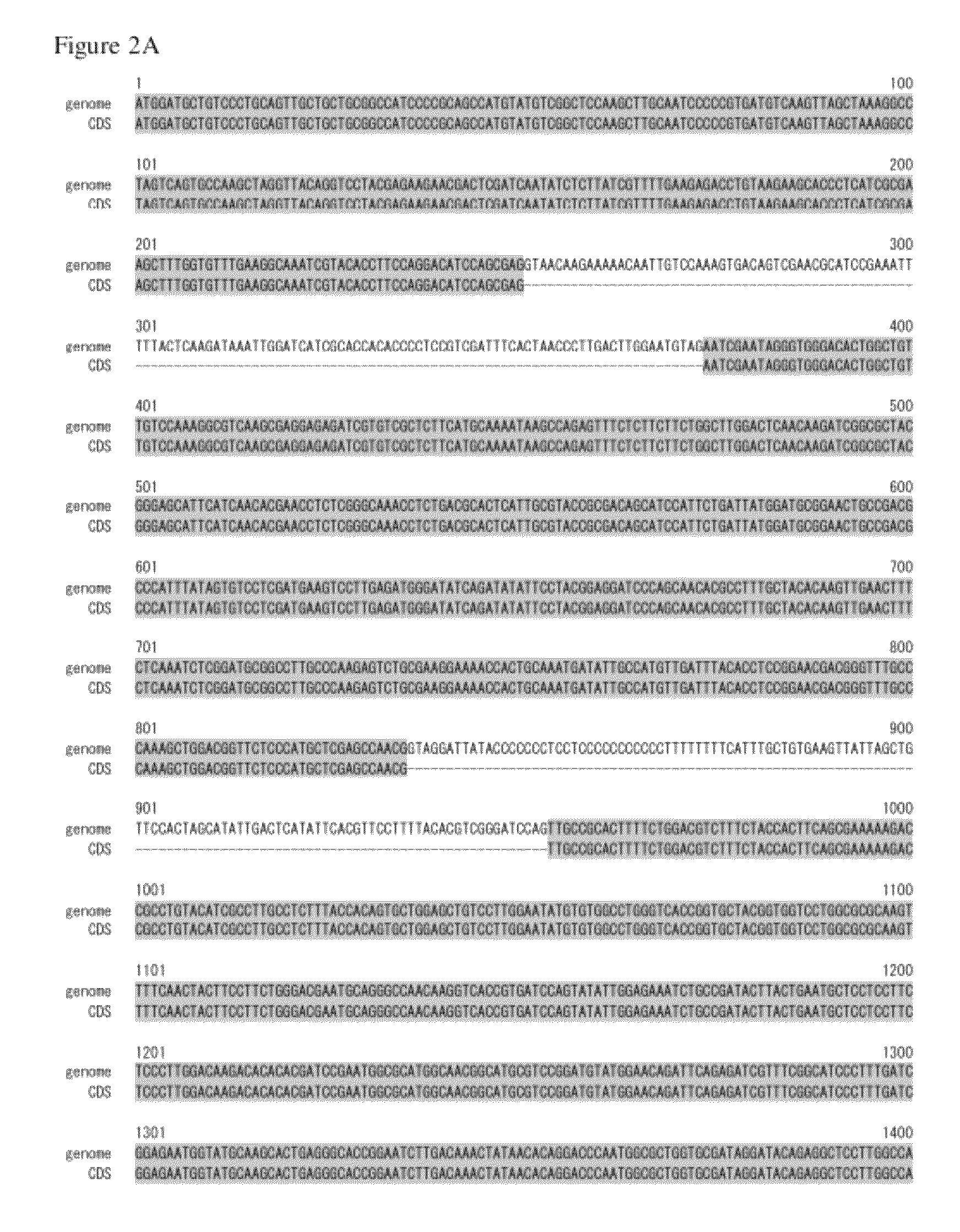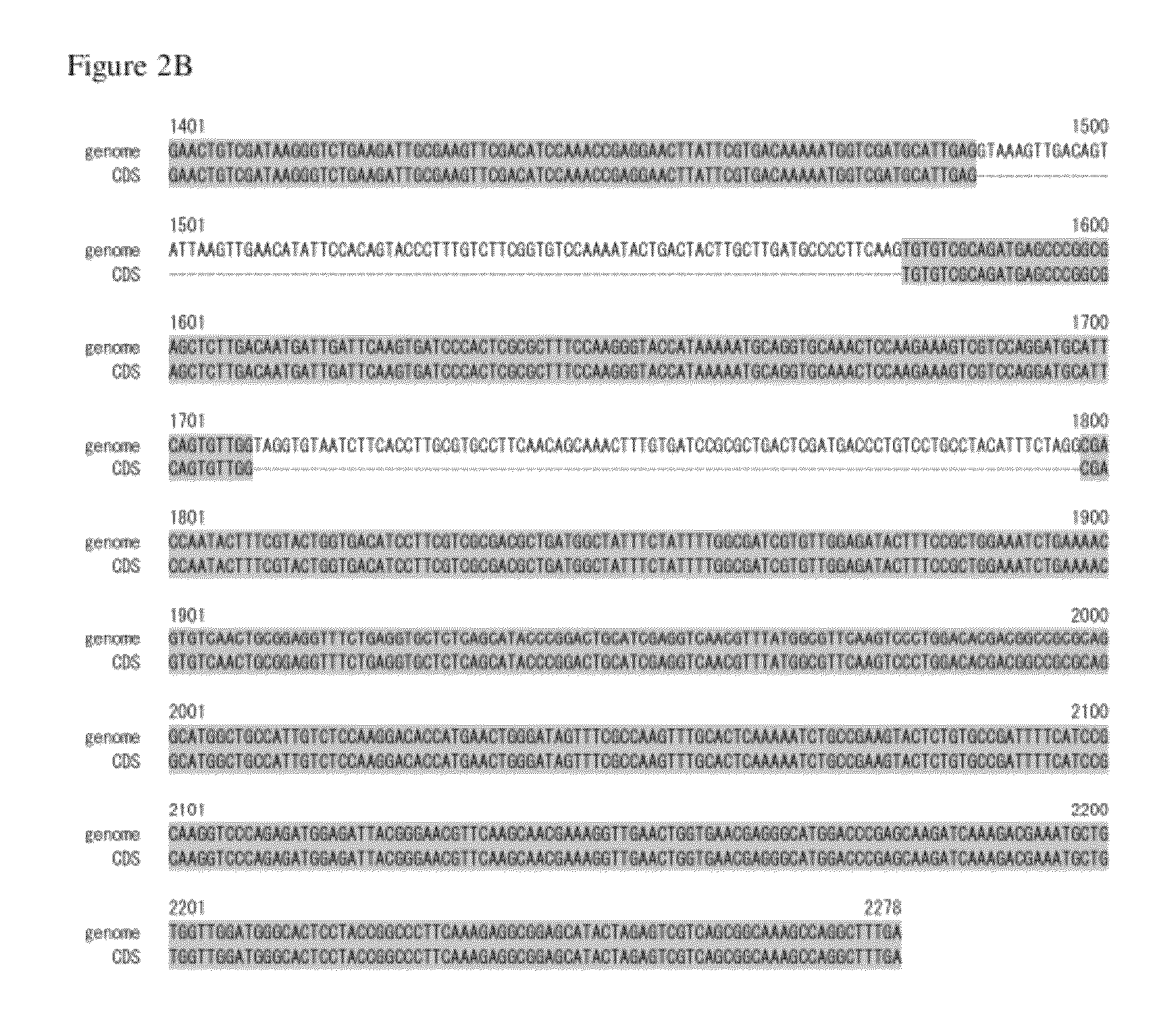Polynucleotide encoding acyl-CoA synthetase homolog and use thereof
a technology of acylcoa and acylcoa, which is applied in the direction of ligases, peptide/protein ingredients, dna/rna fragmentation, etc., can solve the problems of insufficient supply of polyunsaturated fatty acids in animal organs, inability to synthesize polyunsaturated fatty acids in animal bodies, and inability to obtain sufficient quantities for large supplies. achieve the effect of high production efficiency of lipids and fatty acids
- Summary
- Abstract
- Description
- Claims
- Application Information
AI Technical Summary
Benefits of technology
Problems solved by technology
Method used
Image
Examples
example 1
Genome Analysis of M. alpina
[0170]The M. alpina 1S-4 strain was plated on 100 ml of GY2:1 medium (2% glucose and 1% yeast extract, pH 6.0) followed by shake culture at 28° C. for 2 days. The mycelial cells were collected by filtration, and genomic DNA was prepared using DNeasy (QIAGEN). The nucleotide sequence of the genomic DNA described above was determined using a Roche 454 GS FLX Standard. On this occasion, nucleotide sequencing of a fragment library was performed in two runs and nucleotide sequencing of a mate paired library in three runs. The resulting nucleotide sequences were assembled to give 300 supercontigs.
Synthesis of cDNA and Construction of cDNA Library
[0171]The M. alpina strain 1S-4 was plated on 100 ml of medium (1.8% glucose, 1% yeast extract, pH 6.0) and precultured for 3 days at 28° C. A 10 L culture vessel (Able Co., Tokyo) was charged with 5 L of medium (1.8% glucose, 1% soybean powder, 0.1% olive oil, 0.01% Adekanol, 0.3% KH2PO4, 0.1% Na2SO4, 0.05% CaC12.2H2O...
example 2
Construction of Expression Vector
[0293]The vector pYE-ACS-12 for expressing MaACS-12 in yeast was constructed as follows. Using a plasmid containing the cDNA of MaACS-12 as a template, PCR was performed with the following primers using KOD-Plus-(TOYOBO).
[0294]
Primer Eco-ACS-G-F:(SEQ ID NO: 103)5′-GAATTCATGACAAAGTGCCTCACCGTCG-3′Primer Sma-ACS-G-R:(SEQ ID NO: 104)5′-CCCGGGACTTAGGCCGTTCCATAAAGCTG-3′
The amplified DNA fragment was cloned using a Zero Blunt TOPO PCR Cloning Kit (Invitrogen). The nucleotide sequence of the insert was verified and the plasmid containing the correct nucleotide sequence was digested with restriction enzymes EcoRI and SmaI. Using a Ligation High (TOYOBO), the resulting DNA fragment of approximately 2 kbp was ligated to the DNA fragment obtained by digesting vector pYE22m with restriction enzyme BamHI and then blunt ending with a Blunting Kit (TAKARA Bio) and further digesting with EcoRI, to give plasmid pYE-ACS-12.
Expression Vector f...
PUM
| Property | Measurement | Unit |
|---|---|---|
| temperature | aaaaa | aaaaa |
| temperature | aaaaa | aaaaa |
| pH | aaaaa | aaaaa |
Abstract
Description
Claims
Application Information
 Login to View More
Login to View More - R&D
- Intellectual Property
- Life Sciences
- Materials
- Tech Scout
- Unparalleled Data Quality
- Higher Quality Content
- 60% Fewer Hallucinations
Browse by: Latest US Patents, China's latest patents, Technical Efficacy Thesaurus, Application Domain, Technology Topic, Popular Technical Reports.
© 2025 PatSnap. All rights reserved.Legal|Privacy policy|Modern Slavery Act Transparency Statement|Sitemap|About US| Contact US: help@patsnap.com



